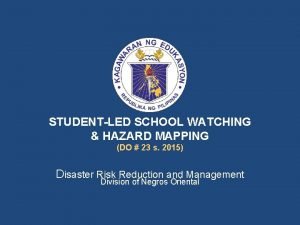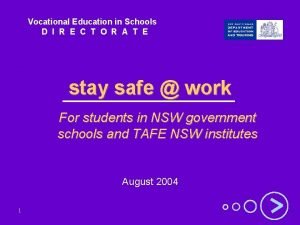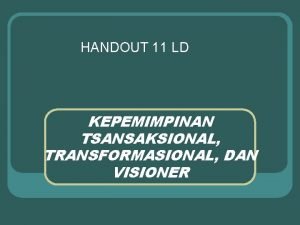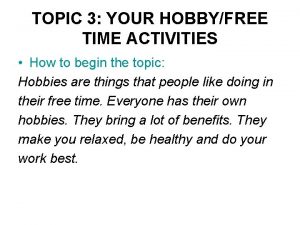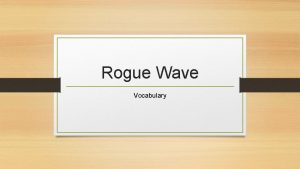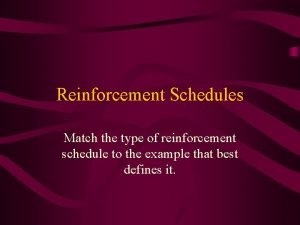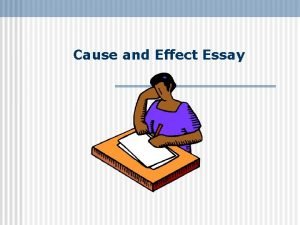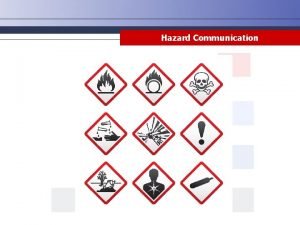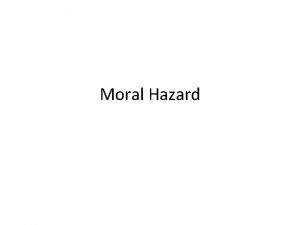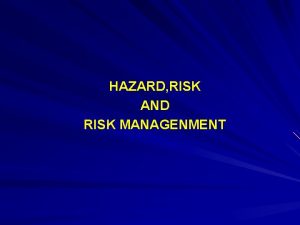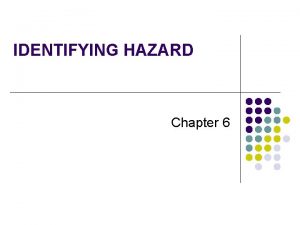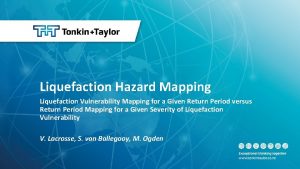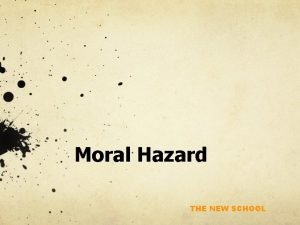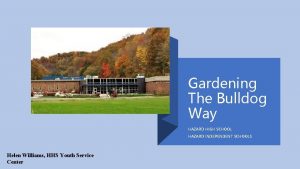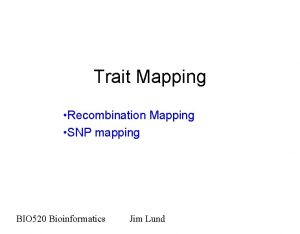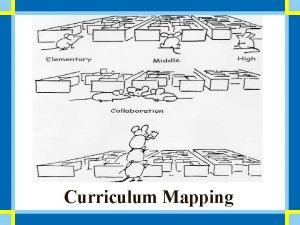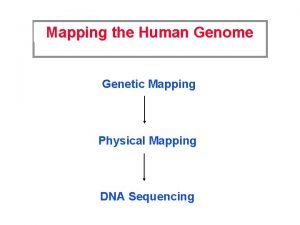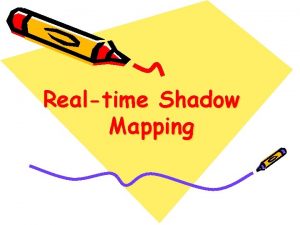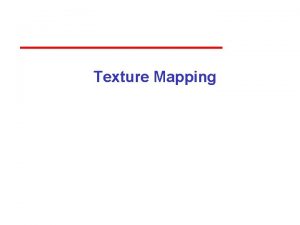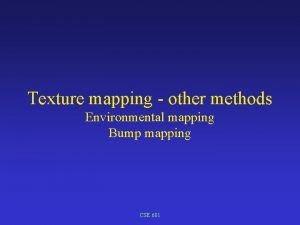STUDENTLED SCHOOL WATCHING HAZARD MAPPING DO 23 s






























- Slides: 30

STUDENT-LED SCHOOL WATCHING & HAZARD MAPPING (DO # 23 s. 2015) Disaster Risk Reduction and Management Division of Negros Oriental

Student-Led School Watching and Hazard Mapping • aims to instruct all public elementary and secondary schools in the specific engagement of learners in identifying and addressing hazards and risks. DEPARTMENT OF EDUCATION 2

The said Guidelines support Dep. Ed Order No. 50, s. 2011 entitled Creation of DRRM Office and Dep. Ed Order No. 55, s. 2007 entitled Prioritizing the Mainstreaming of Disaster Risk Reduction and Management in the School System and Implementation of Programs and Projects Relative Therefore, which seek to mainstream the implementation of DRRM in the systems and processes of the Department at all levels. DEPARTMENT OF EDUCATION 3

GUIDELINES Rationale: Strengthening disaster prevention, mitigation and preparedness is one of the key strategies to address the vulnerabilities of children inside and outside the school. With the increasing effects of climate change, it is important to raise the awareness and capacities of children to prepare for and manage possible disaster and/or emergencies. This is also intended to influence family preparedness as the learners could share and apply their lessons at home. DEPARTMENT OF EDUCATION 4

GUIDELINES Children, who are commonly identified as one of the vulnerable groups, should be equipped with the capacity to know, understand apply safety and protection mechanism to build the foundation of their resilience. To initiate this strategy, it is imperative to increase the awareness of learners on the hazards and possible risk inside the school. DEPARTMENT OF EDUCATION 5

GUIDELINES The student-led school watching and hazard mapping are initial steps in engaging learners in disaster preparedness and management. This activity will raise awareness and equip learners with information and skills necessary for addressing the impact of hazards. Through this activity, the Department of Education creates an opportunity for learners to understand their role in disaster risk reduction and management (DRRM). DEPARTMENT OF EDUCATION 6

OBJECTIVES • Improve students’ level of awareness on the potential hazards and risk within and around schools; • Increase the participation of children in addressing potential disaster by reducing vulnerabilities; and • Inculcate a culture of safety in the day-today experience of children in school DEPARTMENT OF EDUCATION 7

SCOPE This activity shall be conducted by all public elementary and secondary schools DEPARTMENT OF EDUCATION 8

Key Concepts in DRRM HAZARD EXPOSURE A potentially damaging physical event, phenomenon or human activity, which may cause the loss of life or injury, property damage, social and economic disruption or environmental degradation. People, property, systems, or other elements present in hazard zones that are thereby subject to potential losses. (UNISDR, 2004) 2009) e. g. typhoon, flood, earthquake, landslide DEPARTMENT OF EDUCATION 9

Key Concepts in DRRM CAPACITY VULNERABILITY The combination of all the strengths, attributes and resources available within a community, society or organization that can be used to achieve agreed goals. (UNISDR, 2009) A set of conditions and processes resulting from physical, social, economic and environmental factors, which increase the susceptibility of a community to the impact of hazards. (UNISDR, 2004) DEPARTMENT OF EDUCATION 10

Key Concepts in DRRM RISK DISASTER The probability of harmful consequences, or expected loss resulting from interaction between natural or human-induced hazards and vulnerable/capable conditions (UNISDR, 2004) A serious disruption of the functioning of a community or society causing widespread human, material, economic or environmental losses which exceed the ability of the affected community/ society to cope using its own resources. (UNISDR, 2004) DEPARTMENT OF EDUCATION 11

Key Concepts in DRRM PREVENTION AND MITIGATION The limitation of the adverse impacts of hazards and related disasters. Mitigation measures encompass eng’g techniques & hazard-resistant construction as well as improved environmental policies and public awareness (R. A. 10121) PREPAREDNESS The knowledge and capacities developed by governments, professional response and recovery organizations, communities and individuals to effectively anticipate, respond to, and recover from, the Impacts of likely, imminent or current hazard events or conditions. (R. A. 10121) 12 DEPARTMENT OF EDUCATION

Key Concepts in DRRM RESPONSE The provision of emergency services and public assistance during or immediately after a disaster in order to save lives, reduce health impacts, ensure public safety and meet the basic subsistence needs of the people affected. (R. A. 10121) RECOVERY & REHABILITATION Measures that ensure the ability of affected communities/areas to restore their normal level of functioning by rebuilding livelihood and damaged infrastructures and increasing the communities' organizational capacity. (R. A. 10121) 13 DEPARTMENT OF EDUCATION

Risk contributors Risk Hazard Vulnerability Capacity DEPARTMENT OF EDUCATION 14

POLICY STATEMENT This policy shall require all public and secondary schools to organize a student-led school watching and hazard mapping activity every first month of the school year DEPARTMENT OF EDUCATION 15

PROCEDURE A. Organizing and Preparing the School Watching Team • The schools head shall designate a moderator to facilitate a student-led school watching and hazard mapping activity. The moderator is preferably a DRRM-trained school personnel who is familiar with the hazards and risks in the school or anyone who has previous/current involvement in any DRRM activity. DEPARTMENT OF EDUCATION 16

PROCEDURE A. Organizing and Preparing the School Watching Team • The School Watching Team (SWT) should comprise of at least 10 members. For medium and big schools, organizing various students’ organizations and//or student leaders for a school watching activity is preferred to maximize engagement. For very small schools (i. e. with less than five classes), teachers could integrate school watching in their respective lessons as an outdoor activity. For very big schools, more than one team could be organized to ensure that all grade levels, sections and groups are represented DEPARTMENT OF EDUCATION 17

PROCEDURE A. Organizing and Preparing the School Watching Team • The Supreme Student/Pupil Government (SSG/SPG) shall aid in the identification of SWT members. The team members could be student leaders of youth clubs, academic and/or nonacademic clubs such as boy/girl scouts, Red Cross, or representatives from various grade levels and/or sections. • The moderator is encouraged to redesign the process, if necessary, to ensure appropriateness to the composition of the SWT. Preferably SSG/SPG shall also participate in this activity. DEPARTMENT OF EDUCATION 18

PROCEDURE A. Organizing and Preparing the School Watching Team • It is important that the moderator presents the guidelines in the language that the SWT is most familiar and comfortable with. • The moderator could prepare a timeline on the conduct of this activity to ensure that this will not disrupt regular school activities and/or classes of SWT members. • The moderator will prepare route for the school watching, designate stops and provide a School Watching Checklist (D. O. 23 s. 2015) to Team members for guidance in the observation of hazards. DEPARTMENT OF EDUCATION 19

PROCEDURE A. Organizing and Preparing the School Watching Team • Designate a start and end point for the school watching activity. • The moderator shall orient the SSG/SPG on school watching and hazard mapping before convening the SWT. DEPARTMENT OF EDUCATION 20

PROCEDURE B. School Watching and Hazard Mapping • The moderator should ensure that all SWT members have a pen and notebook for note taking during the school watch. • The moderator shall orient the SWT on the background and purpose of this activity, and level-off with the TEAM on the conduct of this activity. • Walk through each building, classroom, office, laboratory, workshop, play area, garden and any open area of the school. DEPARTMENT OF EDUCATION 21

PROCEDURE B. School Watching and Hazard Mapping • At each point, give a 3 -5 minute stop for the Team to observe and take down notes in every building, classroom, office, laboratory, workshop, play area, garden and any open area. • Use the School Watching Checklist as a basic guide in identifying hazards factors and/or at risk areas in the school. The team members are encouraged to add other risk factors based on their observation, experience and appreciation of the condition of the school environment/facilities. DEPARTMENT OF EDUCATION 22

PROCEDURE B. School Watching and Hazard Mapping • After walking around the school premises, the moderator will facilitate the processing of the information noted by the SWT. • Then, materials such as cartolina, pens, crayons, coloured papers or any drawing materials will be distributed to the SWT to map and plot the identified hazards and/or at risk areas in the school. • Allow the SWT to discuss the plotted hazard areas in the map to enhance the initially placed markings. • Finalize the hazard map based on the SWT discussion and prepare for a presentation to the School Planning Team (SPT) DEPARTMENT OF EDUCATION 23

SAMPLE OUTPUT - SCHOOL HAZARD MAP Pinoma National High School, Division of Cauayan City, Region 02 DEPARTMENT OF EDUCATION

SCHOOL WATCHING CHECKLIST Broken window Slippery pathway Blocked corridor Heavy objects mounted on top of cabinets/shelves Flooded area Busted plugs / light bulbs/electrical wires Exposed electrical wires Protruding nails in chairs and tables Broken door knobs Warning sign: Slippery pathways/corridors Plants mounted on the building railings DEPARTMENT OF EDUCATION 25

SCHOOL WATCHING CHECKLIST Exposed chemicals and liquids Unlabeled chemicals Lack/absence of storage for equipment Dripping Ceiling Unpruned trees/bushes/shrubs Open pit Open/Clogged canals Stagnant water No ramps for elevated school building or other facilities Swing-in doors DEPARTMENT OF EDUCATION 26

SCHOOL WATCHING CHECKLIST Broken/dilapidated ceiling Open/incomplete perimeter fence Presence of stray animals inside the school campus Presence of electrical post/transformer near or within the school perimeter No system of release to parents during emergencies No posted emergency hotlines around the school Garbage area (Segregation of Biodegradable and Nonbiodegradable) Detached or peeled off GI sheet Broken chairs/desk/tables Broken toilet bowl and/or sinks DEPARTMENT OF EDUCATION 27

SCHOOL WATCHING CHECKLIST Blocked/no emergency exits Unmounted cabinets/shelves Medical kits in every classrooms Bells alarms Condemnable building (i. e. very old structure, collapsing building and/or prominent cracks on classroom walls) DEPARTMENT OF EDUCATION 28

MONITORING & EVALUATION All Division DRRM Coordinators shall conduct ocular visits to observe and document the conduct of school watching and hazard mapping. Specifically, the Coordinator shall note the implementation issues and submit reports to the DRRMO. This well serve as input to succeeding policy development initiatives. DEPARTMENT OF EDUCATION 29

Thank you! Division of Negros Oriental 22 August 2015
 School watching and hazard mapping
School watching and hazard mapping Mok heng ngee
Mok heng ngee The associative mapping is costlier than direct mapping.
The associative mapping is costlier than direct mapping. Forward mapping vs backward mapping
Forward mapping vs backward mapping Transform mapping dan transaction mapping
Transform mapping dan transaction mapping Hazard vocational school
Hazard vocational school Their eyes were watching god chapter 19-20 summary
Their eyes were watching god chapter 19-20 summary Their eyes were watching god chapter 1 summary
Their eyes were watching god chapter 1 summary Tewwg chapter 9 summary
Tewwg chapter 9 summary Starched and ironed her face
Starched and ironed her face Chapter 7-9 their eyes were watching god
Chapter 7-9 their eyes were watching god Their eyes were watching god chapter 10-12 summary
Their eyes were watching god chapter 10-12 summary Their eyes were watching god chapter 8 summary
Their eyes were watching god chapter 8 summary Their eyes were watching god chapter 9 summary
Their eyes were watching god chapter 9 summary A whale watching company noticed that many customers
A whale watching company noticed that many customers George orwell performer heritage
George orwell performer heritage Their eyes were watching god chapter 2
Their eyes were watching god chapter 2 A boy was watching his grandmother write a letter
A boy was watching his grandmother write a letter My father like reading newspaper model watching tv
My father like reading newspaper model watching tv Watching movies at home
Watching movies at home Why does hurston open the novel with an analogy
Why does hurston open the novel with an analogy My eyes are watching you
My eyes are watching you Gaya kepemimpinan transformasional
Gaya kepemimpinan transformasional Time topic
Time topic I can see the water’s motion by watching how a swell
I can see the water’s motion by watching how a swell Watching and seeing shooting stars on a dark night
Watching and seeing shooting stars on a dark night Biopoem
Biopoem Thank you for watching
Thank you for watching What is the show cesium and iodine love watching
What is the show cesium and iodine love watching My hobbies images
My hobbies images Causes and effects of divorce essay
Causes and effects of divorce essay
